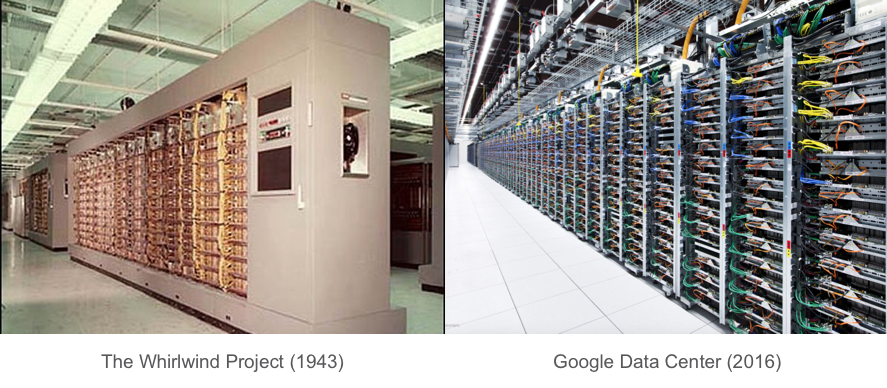History regularly repeats itself. Sometimes it’s exciting and other times not so much. A current market transition I’m excited about happens to be occurring across the entire data center touching compute, storage, and networking. It’s the shift to shared nothing architectures and it takes me back to my studies on high performance computing and how far technology has evolved, yet stayed the same.
In Silicon Valley’s early stages computing was dominated by integrated systems called mainframes which, due to the massive size of the equipment, were often stored in warehouses. Mainframes evolved quickly to meet the rapid growth of new users by leveraging early virtualization and multi-tenancy technologies to create time-shared services. This is similar to cloud computing services that are available today and are also coincidentally housed in warehouses due to the massive amount of equipment needed to provide those services.

The problem with these early “big iron” systems was that even with advancements in technology they could not create economies of scale for those consuming their services. They were limited by the physical resources available within their sheet metal; i.e. finite amounts of compute, memory and storage, available for users to reserve.
When expansion was necessary, “big iron” also didn’t scale incrementally with user demand and was extremely complex to setup and maintain making them cost prohibitive. Further, there were no alternatives as everything top to bottom was a closed system designed and built to work together by a single vendor who controlled architecture, performance optimization and the cost premiums they carried.

This was the first time the technology industry created a user community ripe for dissent. The shift away from mainframes came with the advent of x86 system architectures which scaled incrementally, were much lower cost, and commonly available through a new ecosystem of hardware suppliers. But success in this technology transition was only achieved through some form of software abstraction like Unix, FreeBSD, and Linux operating systems to empower the user to take advantage of this new system architecture. When technology was democratized in this era it was the more user friendly operating systems like those offered commercially from Microsoft along with various middleware software solutions for distributed computing created a lethal combination that challenged the status quo.
Fast forward to the 1990s when servers were more open and the Moore’s Law prediction of costs coming down was proving true. At that time the components by themselves were a performance bottleneck when it came to executing very specific functions within a data center. The need to accelerate certain functions went beyond what was commonly available so uncommon returned shifting back to “big iron” systems architectures. This resulted in a wave of new startups in networking, storage and security all aimed at building appliances; each with purpose built functionality and centralized scale up performance.
The appliance model required interoperability and reference architectures to dictate terms for how to play nice in a multi-vendor environment with each vendor optimizing for their functional role. While the server industry at this time was open for new software development, storage, networking and security were not. There was no ecosystem of software abstraction to democratize the functions they provided or remove their inherent complexity which only the original designing engineers understood.
Even if these appliances were democratized; planning, designing and delivering on multi-vendor products and solutions was not for everyone. Commonly we see businesses preferring the simplicity of single sourcing equipment to simplify procurement, deployment and ongoing support knowing everything works together as designed. It’s even better when you combine best of breed appliances into a single solution to create a better overall experience. This is where converged systems come into play creating prepackaged solutions between industry leading vendors to solve customer operational deficiencies and provide the horsepower to scale up and support the most intensive mission critical workloads.

The changing tide came when new web scale applications emerged forcing the need to scale out quickly and cost effectively to meet user growth. This is where history repeats itself creating an opportunity for an entirely new approach to designing infrastructure to meet the demands of these new data intensive workloads.
The dissent this time came from web 2.0 companies and cloud service providers who found new ways to support their explosive user demands on infrastructure. The seismic shift they triggered was moving from centralized systems architectures to distributed systems architectures with a shared-nothing software abstraction layer pooling the physical compute and storage resources. Even the network architecture changed from a rigid 3-tier hierarchical design to highly scalable IP Clos architectures borrowed from high performance computing practices.
What this new model delivered in terms of end user value is scalability, deterministic performance, fault tolerance and high availability. For an always-on world fueled by instant gratification this shift is paramount. Forbes wrote a great article about this topic but you can also learn more from this informative white paper by Gina Langoria and Jimmy Pike of Moor Insights.
However, none of this signals the death knell for the appliance model no matter what noise is coming from eager infrastructure startups or pundits alike. History has shown even mainframes are still alive and certain workloads simply run better on them or are too difficult to migrate to another system. The major difference is that many of these Web 2.0 companies are built from the ground up supporting homogenous applications and have no legacy applications environments to maintain or interoperate with. They don’t have the same problems the rest of the world has to deal with. This is where the new ecosystem of startups offering solutions on shared nothing architectures comes into play.
While Cisco is not a storage vendor, we are a data center systems and solutions provider. We partner with storage and all-flash array vendors to offer turn-key converged systems for scale up workloads. We also offer our own Cisco HyperFlex solution as the world’s only “complete” hyperconverged system that scales compute and storage independently depending on your workload requirements.
All of these systems are designed, engineered and fully tested to work together and perform optimally with service and support you can trust. And most importantly, Cisco UCS and Cisco HyperFlex are still the industries only complete solutions that fully integrate compute, storage and networking for rack and roll simplicity. It’s really the same reason that some people decide to become an “all Apple” household. It’s about simplicity and ease of use that Apple offers in making various products work together seamlessly. This is what our ASAP Data Center strategy is about and you can learn more about it in this white paper from IDC’s Brad Casemore.

In the new shared nothing storage architecture, I mentioned a new ecosystem of startups have emerged. In this ecosystem, there are many similarities between the hyperconverged and software defined storage players. The main technical differentiation is whether you are running workloads or are simply creating a pool of shared storage accessed similarly to a traditional NAS or SAN. Regardless of the use-case, they all leverage industry standard x86 system architecture to scale incrementally while lowering cost at the same time. Each solution utilizes a distributed abstraction layer to create virtual pool of storage or storage fabric. They differentiate themselves though unique innovations in performance, scalability, fault tolerance, data redundancy and techniques for compression and deduplication to efficiently store large amounts of data.
For customers who choose to pick their own building blocks and tailor their solutions to their unique business, Cisco has built an ecosystem of software defined storage partners. It’s important to us that our customers know that we offer choice. If you do not prefer our integrated systems approach you can choose whatever software you want to achieve your goals. We will make sure these solutions are certified as compatible with our hardware through our Interoperability Verification Testing (IVT) program and work closely with our solution partners to deliver a great experience while doing business together.

Our partners know that running their software on the Cisco Unified Computing System provides the best total cost of ownership over any other server vendor by fully integrating compute, storage and networking into a single management framework. The value we bring as a systems company is not just in the sheet metal but instead the embedded software we designed from scratch to manage the server infrastructure at scale like UCS Director. Now we are extending that same value from compute to storage so you old school storage grey beards should really dig this! Our recent announcement of the UCS S-Series storage server rounds out our UCS family offering high capacity storage that is plug-and-play with existing UCS environments and offers the lowest $/GB. Put that together with one of our storage solution partners and you’re ready to go from Terabytes to Petabytes in no time!

Customers who want choice can confidently count on the Cisco Solution Partner Program to not only enable them to solve their data intensive workload challenges. But also to make it a lot easier to do business with us and our partners. For example, we are getting great traction with the S-Series for handling large data sets in Big Data environments, storing and archiving video surveillance data for digital retail and smart city initiatives, and of course more common things like hosting your user data for business applications like Microsoft Exchange.
Check out our Cisco Marketplace, where you can search for solutions that best meet your needs. We have 1,422 joint solutions in our Technology Solutions Catalog and 111 joint solutions in our Solutions Showcase. Also be sure to check out our Design Zone, which contains reference architectures and Cisco Validated Designs for just about every solution you may be interested in.

If you liked this blog please stay tuned for more on data center storage solutions at Cisco and be sure to follow me on Twitter..
Excellent timing of this blog as hyperconverged is the topic of conversation in my work. Thank you for a well written informative article.
I am glad you liked it and thanks for reading it. Stay tuned for more on this topic.